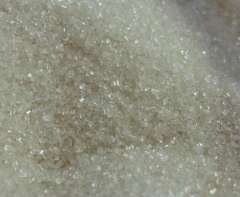Sugar (raw and refined)
From Cargo Handbook - the world's largest cargo transport guidelines website
| Infobox on Sugar (raw and refined) | |
|---|---|
| Example of Sugar (raw and refined) |  |
| Facts | |
| Origin | This table shows only a selection of the most important countries of origin and should not be thought of as exhaustive:
|
| Stowage factor (in m3/t) |
|
| Angle of repose |
|
| Humidity / moisture |
|
| Oil content | - |
| Ventilation | - |
| Risk factors | Unextinguished cigarette ends may cause sugar fires, which are greatly feared because they are difficult to extinguish. Ash acts as a catalyst in combustion. Sugar fires are extinguished with CO2 or chemical extinguishing agents. Raw sugar is highly sensitive to any foreign odors and should thus not be stored together with odor-emitting products. Raw sugar is sensitive to dust, dirt, fats and oils. When exposed to moisture, raw sugar has a tendency to grow mold and form syrup. It may also suffer depreciation as the result of infestation by rats, mice, ants, flies and silverfish. |











